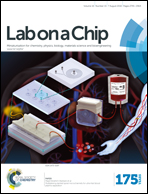Deterministic sequential isolation of floating cancer cells under continuous flow†
Abstract
Isolation of rare cells, such as circulating tumor cells, has been challenging because of their low abundance and limited timeframes of expressions of relevant cell characteristics. In this work, we devise a novel hydrodynamic mechanism to sequentially trap and isolate floating cells in biosamples. We develop a microfluidic device for the sequential isolation of floating cancer cells through a series of microsieves to obtain up to 100% trapping yield and >95% sequential isolation efficiency. We optimize the trappers' dimensions and locations through both computational and experimental analyses using microbeads and cells. Furthermore, we investigated the functional range of flow rates for effective sequential cell isolation by taking the cell deformability into account. We verify the cell isolation ability using the human breast cancer cell line MDA-MB-231 with perfect agreement with the microbead results. The viability of the isolated cells can be maintained for direct identification of any cell characteristics within the device. We further demonstrate that this device can be applied to isolate the largest particles from a sample containing multiple sizes of particles, revealing its possible applicability in isolation of circulating tumor cells in cancer patients' blood. Our study provides a promising sequential cell isolation strategy with high potential for rapid detection and analysis of general floating cells, including circulating tumor cells and other rare cell types.


 Please wait while we load your content...
Please wait while we load your content...